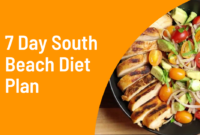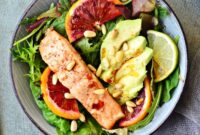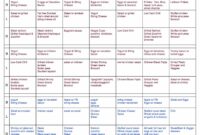South Beach Diet guidelines offer a structured approach to weight loss, emphasizing healthy food choices over restrictive calorie counting. This plan, divided into phases, gradually introduces foods while prioritizing nutrient-rich options. Understanding the principles behind each phase—from the initial restrictions to the long-term maintenance strategies—is crucial for success. This guide provides a detailed overview, exploring the benefits, drawbacks, and practical applications of this popular diet.
The South Beach Diet’s phased approach aims to manage blood sugar levels and promote sustainable weight loss. Phase 1 focuses on eliminating unhealthy fats and refined carbohydrates, leading to initial weight loss. Subsequent phases gradually reintroduce certain foods, helping to prevent the yo-yo dieting effect often associated with more restrictive approaches. The diet also incorporates regular exercise, which is a cornerstone of long-term health and well-being.
Potential Benefits of the South Beach Diet
The South Beach Diet, with its phased approach to weight loss, focuses on reducing refined carbohydrates and unhealthy fats while emphasizing lean protein, healthy fats, and plenty of fruits and vegetables. This approach offers several potential health benefits beyond simply weight management, impacting various aspects of overall well-being. While individual results may vary, numerous studies support the positive effects of this dietary pattern on several key health markers.
The primary benefit often associated with the South Beach Diet is weight loss. This is largely attributed to its emphasis on satiating, nutrient-dense foods, which can help reduce overall calorie intake and promote a feeling of fullness. The controlled carbohydrate intake, especially the initial restriction of simple sugars, also contributes to this effect by preventing blood sugar spikes and subsequent crashes that often lead to increased hunger and cravings.
Weight Loss and Body Composition Changes
The South Beach Diet’s initial phase restricts simple carbohydrates and refined sugars, promoting a reduction in overall calorie intake and fostering weight loss. Studies have shown that diets emphasizing lean protein and healthy fats can be more effective for weight loss than those focusing on restrictive calorie intake alone. The diet’s focus on whole foods also contributes to improved satiety, reducing the likelihood of overeating. For example, a study published in the *Journal of the American College of Nutrition* demonstrated significant weight loss in participants following a low-carbohydrate diet similar in principle to the South Beach Diet. This weight loss was accompanied by reductions in body fat percentage, indicating a positive impact on body composition.
Improved Blood Sugar Control
The South Beach Diet’s emphasis on limiting simple carbohydrates can significantly improve blood sugar control, particularly beneficial for individuals with prediabetes or type 2 diabetes. By avoiding rapid spikes in blood glucose, the diet helps to reduce insulin resistance and improve the body’s ability to regulate blood sugar levels. A controlled study comparing the South Beach Diet to a low-fat diet found that the South Beach Diet led to greater improvements in fasting blood glucose and HbA1c levels, a measure of long-term blood sugar control. This demonstrates the potential of the diet to mitigate the risks associated with high blood sugar.
Improved Lipid Profile
By emphasizing healthy fats and limiting unhealthy saturated and trans fats, the South Beach Diet can contribute to a more favorable lipid profile. This means a reduction in LDL (“bad”) cholesterol and an increase in HDL (“good”) cholesterol, along with a decrease in triglycerides. This improved lipid profile is a crucial factor in reducing the risk of cardiovascular disease. While more research is needed specifically on the South Beach Diet, the principles underlying its approach – reducing saturated fats and increasing healthy fats – are well-established as beneficial for cardiovascular health. The reduction in refined carbohydrates can also positively impact triglyceride levels, another important factor in cardiovascular risk.
Recipes suitable for the South Beach Diet
The South Beach Diet, particularly in Phase 1, emphasizes lean protein, healthy fats, and non-starchy vegetables. Successfully following this phase requires careful meal planning. The following recipes offer delicious and compliant options for breakfast, lunch, and dinner. Each recipe provides a balanced nutritional profile, adhering to the diet’s low-carbohydrate, high-protein principles. Remember to always adjust portion sizes to meet your individual caloric needs.
Phase 1 Breakfast: Scrambled Eggs with Spinach and Mushrooms
This breakfast recipe provides a good source of protein and essential nutrients while remaining low in carbohydrates. The combination of eggs, spinach, and mushrooms offers a flavorful and satisfying start to the day.
| Ingredient | Quantity | Unit | Nutritional Information (per serving, approximate) |
|---|---|---|---|
| Eggs | 2 | Large | 140 calories, 13g protein, 1g carbohydrate, 10g fat |
| Spinach | 1 cup | Chopped | 7 calories, 1g protein, 1g carbohydrate, 0g fat |
| Mushrooms | ½ cup | Sliced | 15 calories, 1g protein, 2g carbohydrate, 0g fat |
| Olive Oil | 1 tsp | – | 40 calories, 0g protein, 0g carbohydrate, 4.5g fat |
| Salt and Pepper | To taste | – | 0 calories, 0g protein, 0g carbohydrate, 0g fat |
Instructions:
- Heat olive oil in a non-stick pan over medium heat.
- Add sliced mushrooms and sauté for 3-4 minutes until softened.
- Add chopped spinach and cook for another 2 minutes until wilted.
- Whisk eggs with salt and pepper.
- Pour eggs into the pan and scramble until cooked through.
- Serve immediately.
Phase 1 Lunch: Tuna Salad with Avocado and Celery
This lunch option provides a healthy dose of protein and healthy fats, keeping you feeling full and satisfied throughout the afternoon. The avocado adds creaminess and healthy fats, while celery provides fiber and crunch.
| Ingredient | Quantity | Unit | Nutritional Information (per serving, approximate) |
|---|---|---|---|
| Tuna (canned in water) | 5 oz | – | 120 calories, 25g protein, 0g carbohydrate, 3g fat |
| Avocado | ¼ | Medium | 80 calories, 2g protein, 5g carbohydrate, 7g fat |
| Celery | ½ cup | Chopped | 6 calories, 0g protein, 1g carbohydrate, 0g fat |
| Lemon Juice | 1 tbsp | – | 3 calories, 0g protein, 1g carbohydrate, 0g fat |
| Salt and Pepper | To taste | – | 0 calories, 0g protein, 0g carbohydrate, 0g fat |
Instructions:
- Drain tuna and flake it.
- Chop avocado and celery.
- Combine tuna, avocado, celery, and lemon juice in a bowl.
- Season with salt and pepper to taste.
- Serve on lettuce leaves or with a side of mixed greens.
Phase 1 Dinner: Baked Salmon with Asparagus
This dinner provides a lean protein source in salmon and a serving of non-starchy vegetables in asparagus. Baking the salmon keeps it healthy and moist.
| Ingredient | Quantity | Unit | Nutritional Information (per serving, approximate) |
|---|---|---|---|
| Salmon Fillet | 4 oz | – | 200 calories, 25g protein, 0g carbohydrate, 10g fat |
| Asparagus | 1 cup | – | 20 calories, 2g protein, 3g carbohydrate, 1g fat |
| Olive Oil | 1 tsp | – | 40 calories, 0g protein, 0g carbohydrate, 4.5g fat |
| Lemon Juice | 1 tbsp | – | 3 calories, 0g protein, 1g carbohydrate, 0g fat |
| Salt and Pepper | To taste | – | 0 calories, 0g protein, 0g carbohydrate, 0g fat |
Instructions:
- Preheat oven to 400°F (200°C).
- Place asparagus spears on a baking sheet.
- Drizzle asparagus with olive oil, salt, and pepper.
- Place salmon fillet on the same baking sheet.
- Drizzle salmon with olive oil and lemon juice. Season with salt and pepper.
- Bake for 12-15 minutes, or until salmon is cooked through and asparagus is tender.
Visual Representation of a South Beach Diet Meal Plan
A balanced South Beach Diet meal is more than just a collection of foods; it’s a vibrant display of colors, textures, and thoughtfully portioned ingredients working together to create a satisfying and healthy experience. The visual appeal of the meal itself can be a powerful motivator, reinforcing the positive aspects of the diet and encouraging adherence.
Imagine a photograph showcasing a meal that perfectly embodies the principles of the South Beach Diet. The image is bright and inviting, focusing on the freshness and quality of the ingredients.
A Sample South Beach Meal: Visual Description
The centerpiece of the image is a generous portion of grilled salmon, its pinkish-orange hue contrasting beautifully with the vibrant greens of a side salad. The salmon is cooked to perfection, displaying a slightly flaky texture and a glistening surface. The salad is a colorful mix of spinach, cherry tomatoes (bright red), cucumber (pale green), and a few slivers of red bell pepper. A light lemon vinaigrette adds a touch of shine and accentuates the fresh flavors. Beside the salad rests a small portion of quinoa, its pearly white grains providing a textural contrast to the softer salmon and crisp vegetables. A sprinkle of chopped fresh parsley adds a pop of green and enhances the overall visual appeal. The portion sizes are moderate, reflecting the balanced approach of the South Beach Diet; the salmon occupies roughly one-third of the plate, the salad another third, and the quinoa makes up the remaining portion. The entire arrangement is visually appealing, showcasing a healthy, delicious, and satisfying meal. The absence of processed foods, refined carbohydrates, and excessive fats is clearly evident in the image’s overall clean and fresh presentation.
Outcome Summary
Successfully navigating the South Beach Diet requires commitment and a clear understanding of its principles. By following the guidelines carefully, paying attention to portion sizes, and incorporating regular exercise, individuals can achieve significant weight loss and improved health markers. Remember that this diet, like any other, should be approached with caution, and consulting a healthcare professional before starting is always advisable. The South Beach Diet, with its emphasis on balanced nutrition and sustainable lifestyle changes, offers a potentially effective path towards a healthier, happier you.




